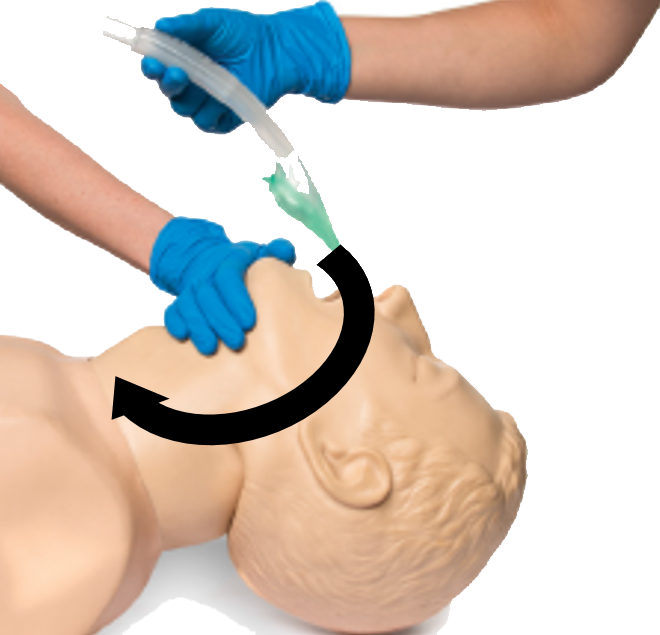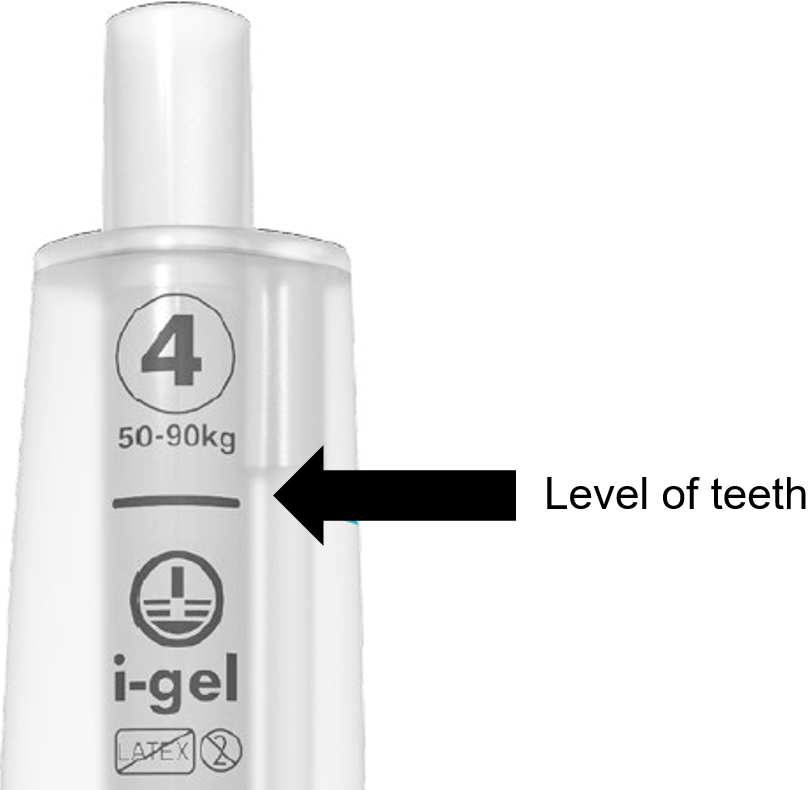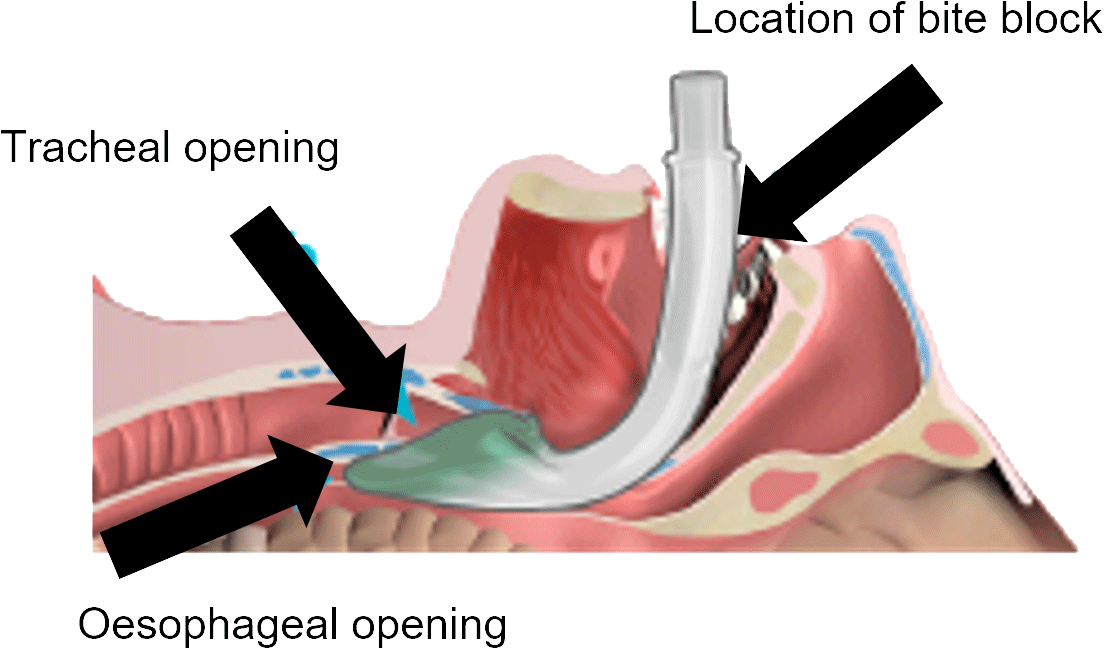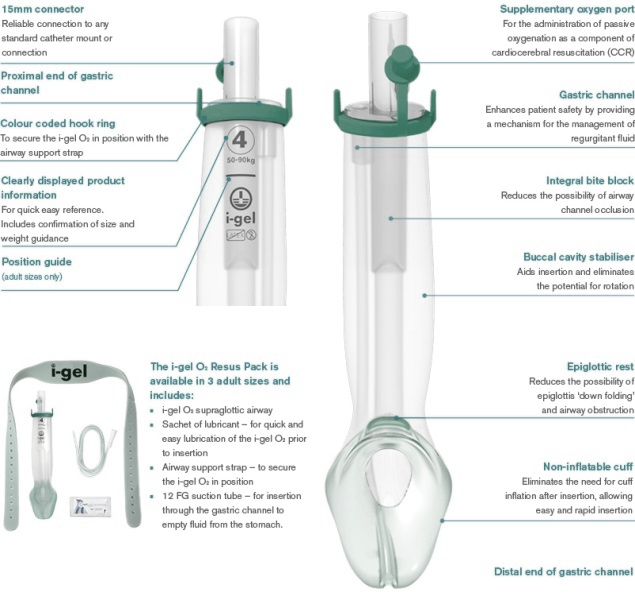
- Supraglottic device refers to i-Gel.
- To manage and maintain a compromised airway in the patient with absent pharyngeal and laryngeal reflexes.
- Intact gag reflex
- Stabilise patient’s head and neck to avoid flexion, rotation or traction during placement
- Confirm placement every time the patient is moved
- Consider gentle use of laryngoscope blade as tongue depressor in infants
- EtCO2 monitoring MUST be applied when available
- Adopt a 30:2 regime during cardiac arrest with mechanical CPR device
- Prepare equipment required:
- Appropriate size i-Gel®
- BVM
- Disposable catheter mount
- Lubricant (NB: Back, both sides and tip)
- Oxygen
- Stethoscope
- Airway support strap
- Suction
- EtCO2
- Select appropriate i-Gel® size according to patient weight as shown on packaging:
- Apply lubricant to posterior surface of i-Gel® - this will aid in creating a good seal
- Pre-oxygenate the patient if appropriate
- Ensure airway is clear.
- Place patient’s head in the ‘sniffing’ position using appropriate padding/ neutral position in suspected cervical spine trauma.
- Push the mandible towards the thorax, insert the i-Gel® into the patient’s mouth (1) with the tip of the mask against the hard palate.
- Glide the device as far as it will go along the hard palate until definitive resistance is felt.
- Attach the catheter mount and EtCO2
- Manually stabilise the device, gently inflate the lungs to test for air entry and seal.
- Auscultate chest to confirm placement.
- Secure the i-Gel® in a central position with the securing strap, or a tape-tie in smaller sizes.
- The i-gel® forms a seal in the airway; this is referred to as a non-inflating cuff.
- It may take a few minutes to form a good seal - be mindful of ventilation pressure and timing of ventilation with chest compression if there is cuff leak). Adopting a 30:2 strategy may mitigate cuff leak in the first instance.
- Effective ventilations (i.e.: adequate chest rise and fall) cannot be achieved (some air leakage can be expected)
- GCS of the patient increases with a return of gag reflex or patient attempts to remove
- i-Gel is faulty.
- Regurgitation occurs and is anticipated to be compromising
Removal of i-Gel
- Remove securing tape/strap.
- Suction if required.
- If patient is conscious, instruct them to take a deep breath and cough as device removed
- Remove the device gently by following the anatomical landmarks.
| Settings | |
|---|---|
| Extended Care: | |
| Colour assist: | |
Document Control
Clinical Resources Website
St John Ambulance Western Australia Ltd (ABN 55 028 468 715) (St John WA) operates ambulance and other pre-hospital clinical services. St John WA’s Clinical Resources, including its Clinical Practice Guidelines (Clinical Resources), are intended for use by credentialed St John WA staff and volunteers when providing clinical care to patients for or on behalf of St John WA, within the St John WA Clinical Governance Framework, and only to the extent of the clinician’s authority to practice.
Other users – Terms of Use
The content of the St John WA Clinical Resources is provided for information purposes only and is not intended to serve as health, medical or treatment advice. Any user of this website agrees to be bound by these Terms of Use in their use of the Clinical Resources.
St John WA does not represent or warrant (whether express, implied, statutory, or otherwise) that the content of the Clinical Resources is accurate, reliable, up-to-date, complete or that the information contained is suitable for your needs or for any particular purpose. You are responsible for assessing whether the information is accurate, reliable, up-to-date, authentic, relevant, or complete and where appropriate, seek independent professional advice.
St John WA expressly prohibits use of these Clinical Resources to guide clinical care of patients by organisations external to St John WA, except where these organisations have been directly engaged by St John WA to provide services. Any use of the Clinical Resources, with St John WA approval, must attribute St John WA as the creator of the Clinical Resources and include the copyright notice and (where reasonably practicable) provide a URL/hyperlink to the St John WA Clinical Resources website.
No permission or licence is granted to reproduce, make commercial use of, adapt, modify or create derivative works from these Clinical Resources. For permissions beyond the scope of these Terms of Use, including a commercial licence, please contact medservices@stjohnambulance.com.au
Where links are provided to resources on external websites, St John WA:
- Gives no assurances about the quality, accuracy or relevance of material on any linked site;
- Accepts no legal responsibility regarding the accuracy and reliability of external material; and
- Does not endorse any material, associated organisation, product or service on other sites.
Your use of any external website is governed by the terms of that website, including any authorisation, requirement or licence for use of the material on that website.
To the maximum extent permitted by law, St John WA excludes liability (including liability in negligence) for any direct, special, indirect, incidental, consequential, punitive, exemplary or other loss, cost, damage or expense arising out of, or in connection with, use or reliance on the Clinical Resources (including without limitation any interference with or damage to a user’s computer, device, software or data occurring in connection with such use).
Cookies
Please read this cookie policy carefully before using Clinical Resources from St John WA.
The cookies used on this site are small and completely anonymous pieces of information and are stored on your computer or mobile device. The data that the cookies contain identify your user preferences (such as your preferred text size, scope / skill level preference and Colour Assist mode, among other user settings) so that they can be recalled the next time that you visit a page within Clinical Resources. These cookies are necessary to offer you the best and most efficient possible experience when accessing and navigating through our website and using its features. These cookies do not collect or send analytical information back to St John WA.
Clinical Resources does integrate with Google Analytics and any cookies associated with this service enable us (and third-party services) to collect aggregated data for statistical purposes on how our visitors use this website. These cookies do not contain personal information such as names and email addresses and are used to help us improve your user experience of the website.
If you want to restrict or block the cookies that are set by our website, you can do so through your browser setting. Alternatively, you can visit www.internetcookies.com, which contains comprehensive information on how to do this on a wide variety of browsers and devices. You will find general information about cookies and details on how to delete cookies from your device. If you have any questions about this policy or our use of cookies, please contact us.



